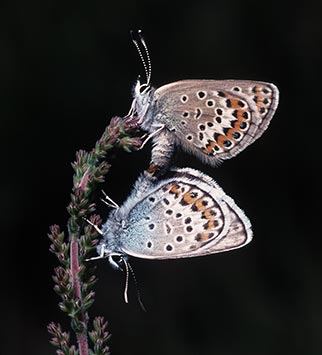Silver-studded Blue (Plebejus argus)
When: Mid-June to late August
How many: Some colonies are made up of enormous numbers

Formerly known as the Lead Argus, the Silver-studded Blue butterfly is without doubt a jewel in the New Forest’s heathland crown, an insect that in much of Britain is extremely rare, restricted to areas of lowland heath, sand dunes and, a few calcareous grasslands.
Yet on many of the New Forest’s heaths, particularly where the vegetation is kept short by grazing or fire, Silver-studded Blues, tiny, colourful, largely sedentary insects, are common and widespread.
In fact, during the flight season, Silver-studded Blues are by far the likeliest butterfly to be encountered, sometimes in colonies thousands strong. It’s even tempting to suggest that any blue butterfly present in good numbers on a New Forest heath from the end of June to mid-August will be a Silver-studded Blue.
Confirmation, however, can be obtained by looking closely at the creature.
On the male Silver-studded Blue's upperwings, deep blue ground colour, clear white fringe and broad, black band are immediately diagnostic. Underwings have a silver sheen, whilst the hindwing also has a noticeable orange band, and black eyespots centred with a bright blue-green stud that, in part, gives the butterfly its name.
Silver-studded Blue females, though, are altogether duller creatures. Dark brown above, but often tinged with blue, they, like the male, have a white fringe on the upperwings and a broad black band, but also a row of dark-centred, orange eyespots. Underwing markings are similar to those of the male, but set against a deep brown background.
And as with other blues butterflies, the Silver-studded Blue has a quite incredible life cycle that features in the early stages a mutually beneficial relationship with, of all things, ants!
Eggs are laid singly, low down on the stems of heathers or gorse, preferably close to where the ants occur. The eggs remain in place throughout the following autumn and winter, and hatch in spring. The Silver-studded Blue caterpillars are then tended and protected by the ants in return for sweet secretions exuded by the caterpillars, and later the pupae.
Butterflies eventually emerge, and the whole remarkable cycle starts afresh.
References:
Butterflies of the British Isles: J.A. Thomas
The Butterflies of Hampshire: Matthew Oates, John Taverner, David Green et al
The Millennium Atlas of Butterflies in Britain and Ireland: Jim Asher, Martin Warren, Richard Fox, Paul Harding, Gail Jeffcoate and Stephen Jeffcoate
The Butterflies of the British Isles: Richard South
More links
Other related links
Search this site

Sadly, 58 animals were killed - 35 ponies, 13 cows, 8 donkeys and 2 sheep, whilst a further 32 were injured - 3 pigs, 9 donkeys, 11 cows and 9 ponies.
(Forty-three accidents occurred in daylight, 15 at twilight and 101 in the dark. Twenty-seven accidents were not reported by the driver involved).
Here's just one horrific example - Three donkeys killed in collision with van at notorious New Forest blackspot (Advertiser and Times)

